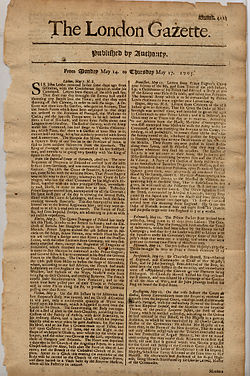The London Gazette

The London Gazette is one of the official records of the British government, and one of the most important in the UK. The London Gazette claims to be the oldest surviving English newspaper. It was first published on 7 November 1665. It is not a normal newspaper with typical news stories. The London Gazette is still published each weekday, except for Bank Holidays. The Gazette is being put online and records between the years 1752–1998 are online.[1][2]
History

The London Gazette was first published as the Oxford Gazette on 7 November 1665. Charles II and the Royal Court had moved to Oxford to escape the Great Plague of London, and courtiers were unwilling to touch, let alone read, London newspapers for fear of becoming ill. When the King returned to London after the end of the plague the Gazette moved too. The first issue of the London Gazette (labelled No. 24) was published on 5 February 1666. The Gazette was not a newspaper in the modern sense: it was sent in manuscript by post to subscribers. It was not printed for sale to the general public.
Traditions
In time of war, dispatches from the various conflicts are published in the London Gazette. People referred to are said to have been mentioned in despatches. When members of the armed forces are promoted, and these promotions are published here, the person is said to have been “gazetted”.
Being "gazetted" (or "in the gazette") sometimes also meant becoming bankrupt. Notices of engagement and marriage also used to be published in the Gazette.
References
- ↑ "Welcome to Gazettes". Archived from the original on 2011-03-08. Retrieved 2008-09-03.
- ↑ "Search the London Gazette Archive". Archived from the original on 2008-12-06. Retrieved 2008-09-03.
Other websites
- London, Edinburgh and Belfast Gazettes Archived 2010-04-20 at the Wayback Machine
- TSO (The Stationery Office)